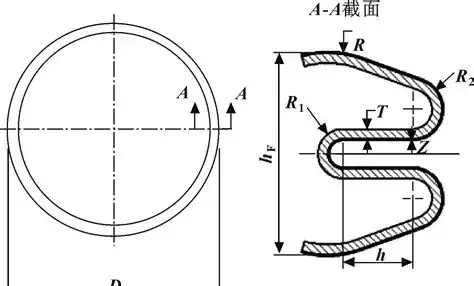News
A2025-08-27

In advanced industrial applications, equipment often operates in extreme environments—enduring temperatures of hundreds of degrees Celsius, ultra-high pressures measuring thousands of atmospheres, highly corrosive media, or cryogenic vacuums. Under these conditions, conventional elastomeric seals fail instantly. Here, the metal W-shaped seal (or metal W-ring), which functions based on its unique metallic structure and physical principles, becomes the critical and final line of defense for system safety and reliability.
I. Core Design: An In-Depth Analysis of the W-Shaped Structure
The metal W-seal is named for its distinct cross-sectional "W" profile. This seemingly simple shape is the product of meticulous engineering and precision manufacturing, with every detail serving a specific functional purpose.
Typically fabricated from high-performance elastic metal strips (such as Inconel, stainless steel 316L, or Hastelloy) via precision roll-forming and finished with advanced welding techniques for a seamless and consistent ring, its structure can be broken down as follows:
Dual Sealing Lips: These are the finest and most critical features, located at the two apexes of the "W." They act like sharp blades, establishing initial line contact with the sealing groove's mating surface (typically a flange face). The bolt preload required is minimal, needing only to create a slight elastic deformation at these thin lip edges to form the initial seal.
Hollow Arch-Sectioned Elastic Cavity: This is the core functional element—the large, hollow concave section forming the center of the "W." It acts as an efficient energy-storing spring mechanism. Its hollow design provides the necessary space for controlled deformation.
Pressure-Energization: When system pressure is applied, it acts on the inner walls of this cavity, attempting to expand the "arch." This action generates a powerful reaction force that drives the two sealing lips against the groove walls with a force significantly exceeding the initial bolt preload. The seal becomes tighter as pressure increases, ensuring outstanding reliability.
This dual sealing mechanism—combining initial mechanical preload and automatic pressure-energization—is the fundamental reason for its exceptional performance in extreme conditions.
II. Unparalleled Advantages: The High-Performance Choice
This ingenious design delivers a suite of superior benefits:
Exceptional Self-Energizing Sealing: The sealing force increases autonomously with rising system pressure, making it ideal for applications with pulsating or shock pressures. It effectively prevents extrusion and leakage under high pressure, a key advantage over many static seals.
Low Bolt Load Requirement: The minimal initial sealing force required allows for simpler flange designs. This can lead to weight reduction (critical in aerospace), smaller or fewer bolts, and less stringent flange machining tolerances.
Superior Performance in Both High Pressure and Vacuum: The self-energizing principle functions equally effectively under high internal pressure and full vacuum. In vacuum applications, external atmospheric pressure provides the energizing force to maintain the seal.
Outstanding Resistance to Extreme Environments: Its all-metal construction withstands extreme thermal cycling (from cryogenic to over 1000°C) and resists a wide range of aggressive chemicals, solvents, and oxidizing agents, far surpassing the capabilities of non-metallic seals.
Reusability: Provided the sealing lips are not damaged and the metal's elasticity is maintained, the seal can often be reused after disassembly, reducing long-term maintenance costs.
III. Applications: Guarding Critical Frontiers
These capabilities make the metal W-seal the preferred choice in demanding fields:
Aerospace: Rocket engine combustion chambers, fuel and hydraulic systems, and aircraft door seals, where reliability, light weight, and performance across extreme temperatures are paramount.
Oil & Gas: Downhole tools, blowout preventers (BOPs), high-pressure valves, and wellheads, capable of withstanding extreme downhole pressures and sour (H₂S) environments.
Nuclear Power: Reactor pressure vessels, primary pumps, steam generators, and waste processing equipment, where absolute leak-tightness is critical for safety.
Chemical & Pharmaceutical: High-pressure reactors and piping systems requiring purity and resistance to aggressive media.
Energy & Research: Superconducting magnets, particle accelerator vacuum chambers, and cryogenic research equipment requiring ultra-high vacuum and extreme temperature seals.
Conclusion
The metal W-seal is a masterclass in engineering, marrying the resilience of metal with intelligent structural design. It transcends the limitations of material-based elasticity by leveraging system energy to create a supremely reliable, pressure-energized seal. It is an indispensable solution for modern industry's most challenging applications, rightfully earning its title as a premier high-performance sealing technology.
[DLSEALS kindly Reminder] Sealing issues? Turn to DLSEALS! As a sealing component manufacturer, we specialize in customizing sealing components, providing a full range of services from design, research and development, production, testing, and more. If you have more information you'd like to know, feel free to contact us directly. DLSEALS's product experts are dedicated to serving you!